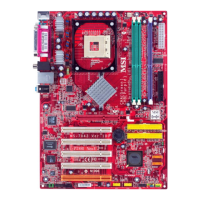
Do you have a question about the MSI MS-7043 and is the answer not in the manual?
| Model | MSI MS-7043 |
|---|---|
| Form Factor | ATX |
| Max Memory | 4 GB |
| Supported CPUs | Intel Pentium 4, Celeron |
| USB Ports | 8 x USB 2.0 |
| Audio | Realtek ALC655 6-channel |
Essential safety precautions for handling the motherboard and its components.
Details CPU, Chipset, Memory, Slots, IDE, and SATA interfaces.
Describes integrated peripherals, audio, LAN, BIOS, dimension, and mounting.
Visual guide to component placement and connector identification.
Highlights MSI-specific features like Color Management and CoreCenter.
Explains the Speedster, PowerPro, LifePro, and BuzzFree features of the Core Cell chip.
Details optional components like Round Cable, CPU Thermal Protection, Live BIOS/Monitor, D-Bracket, S-Bracket.
Visual identification of mainboard components and connectors.
CPU support, installation procedures for Socket 478, and CPU fan mounting.
Guide to installing DDR DIMMs, capacity limits, and dual-channel configuration.
Details ATX power connectors and back panel I/O ports.
Explains FDD, IDE, SATA, Fan, and Front Panel audio/USB connectors.
Information on Clear CMOS jumper and AGP/PCI slot configurations.
How to access BIOS, boot menu, and use control keys.
Overview of BIOS menus, default settings, and help features.
Setting system date, time, and IDE/Floppy drive parameters.
Covers Quick Boot, Boot Sequence, CPU technologies, and security options.
Adjusting DRAM and AGP timings, voltages, and frequencies for performance.
Configuring sleep states, wake-up events, and power button functions.
Configuring PCI, peripherals, and monitoring system health status.
Adjusting CPU, AGP, DRAM frequencies and voltages, including overclocking.
Setting BIOS passwords and loading optimal or high-performance defaults.
Steps to install the VIA audio driver and configure the audio utility.
Diagrams for connecting speakers in 2, 4, and 6-channel modes.
Overview of RAID technology, levels (0 and 1), and VIA VT8237 features.
How to enter VIA RAID BIOS, create, and manage RAID arrays.
Procedures for deleting RAID arrays and managing spare drives.
Steps for rebuilding broken RAID 1 arrays and installing RAID drivers/utilities.